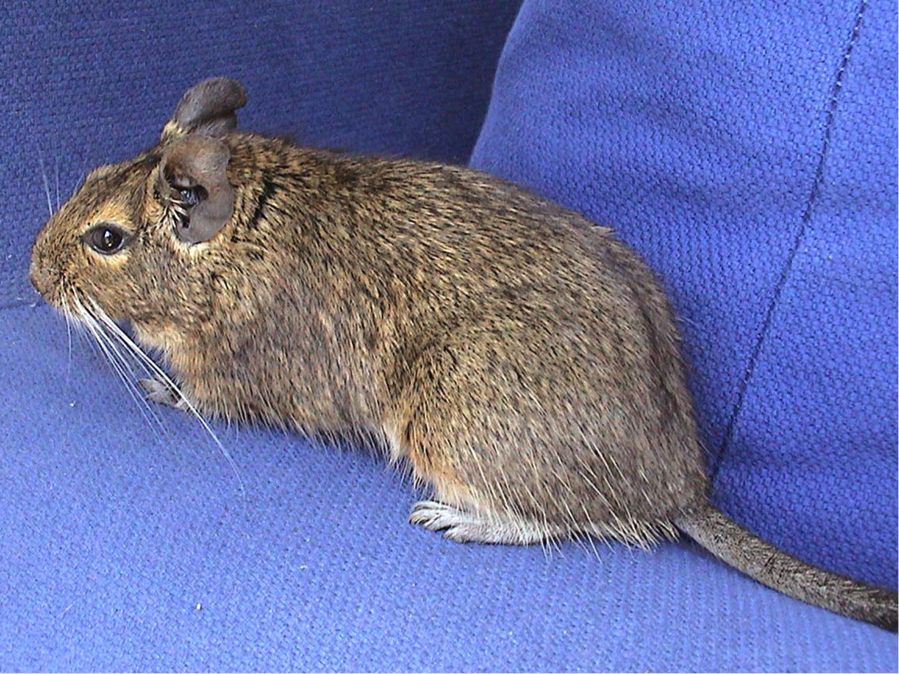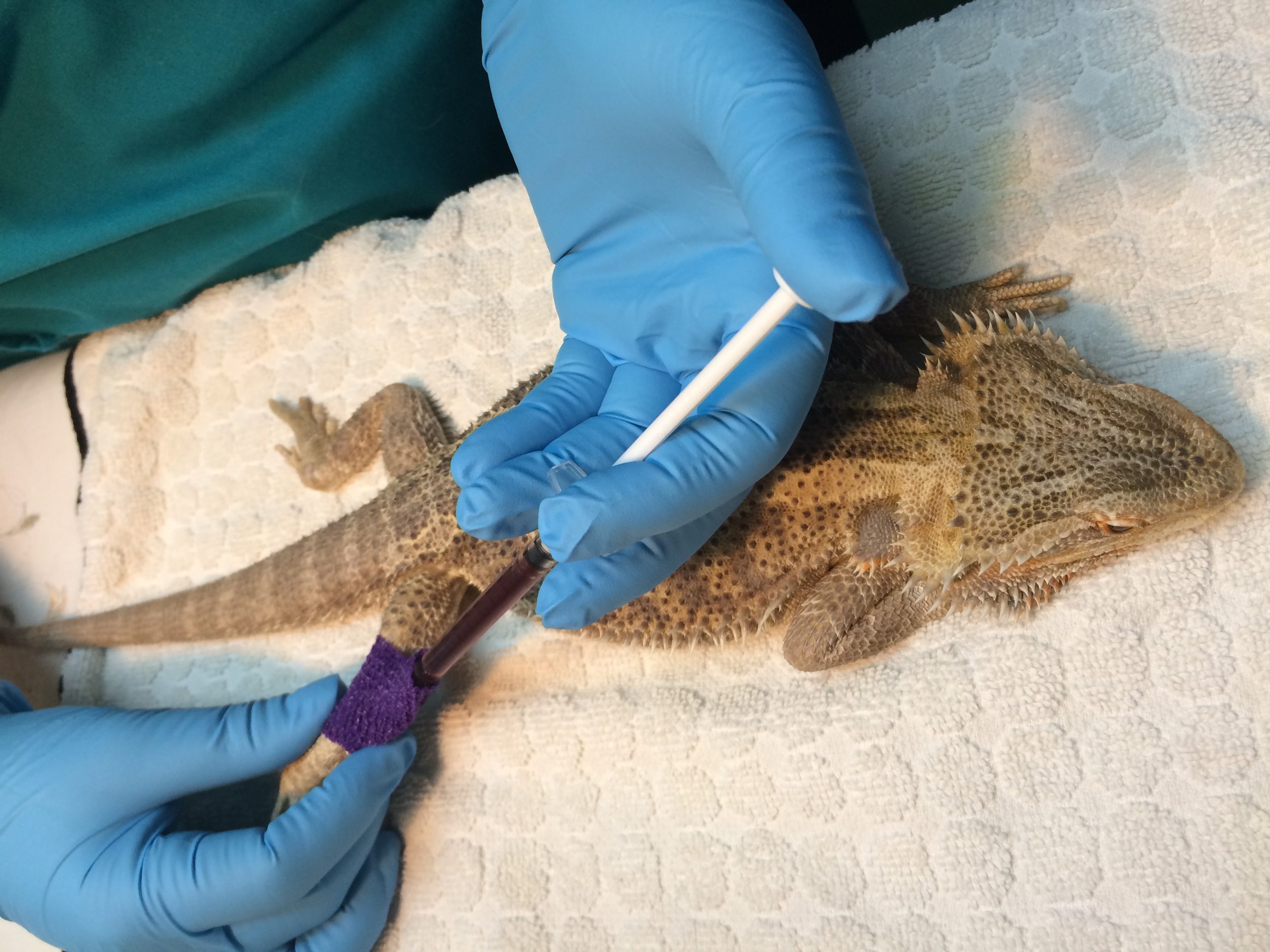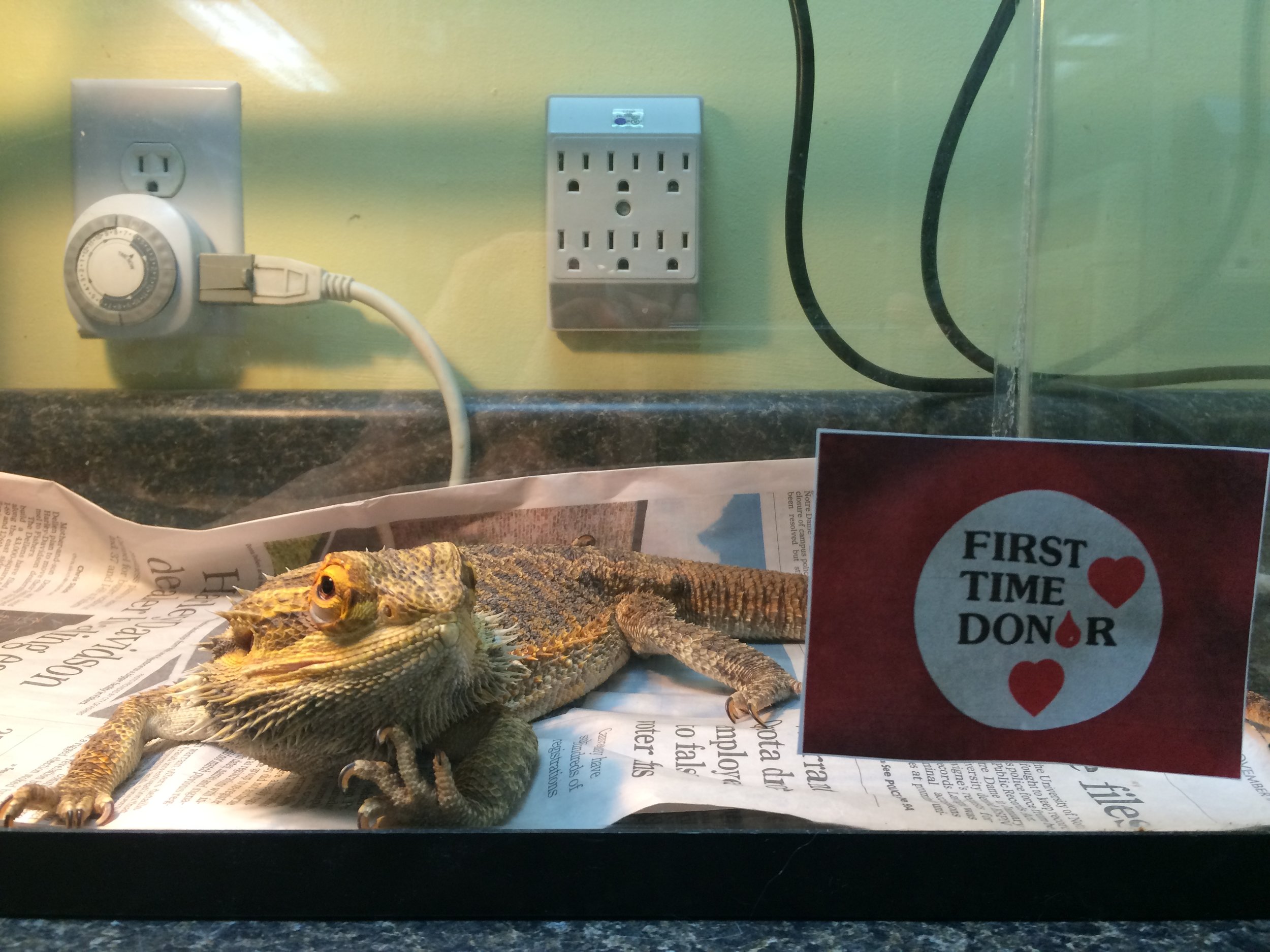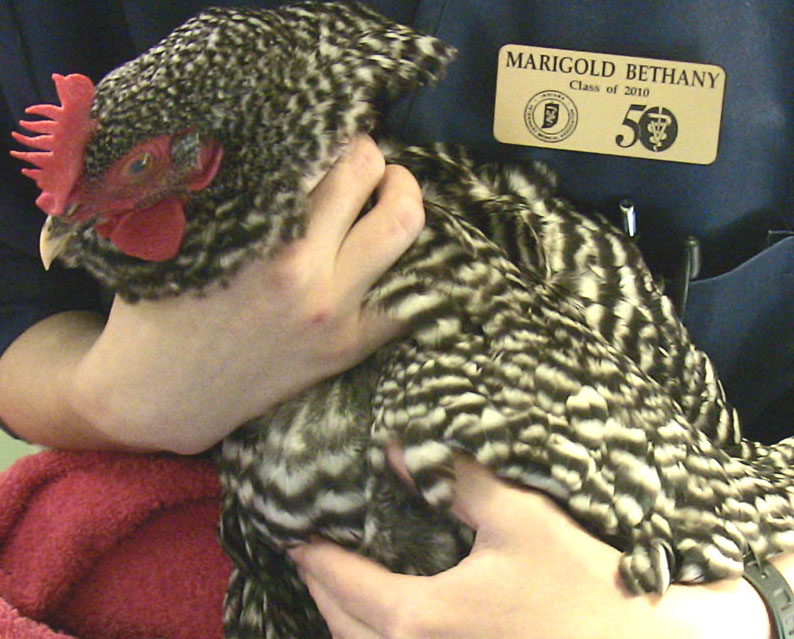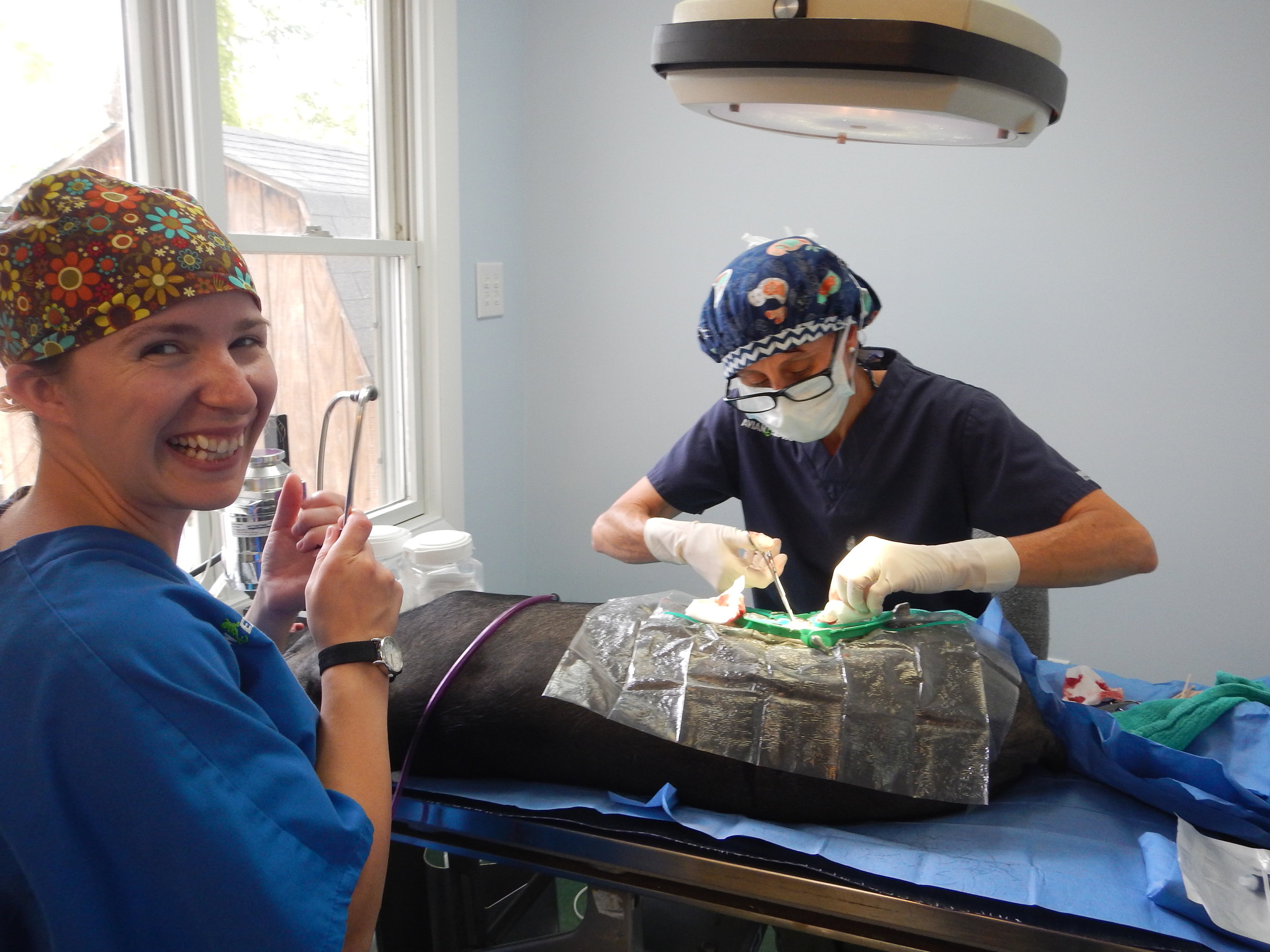Traveling with Your Exotic Companion?
 How do you find a good qualified exotic veterinarian when an injury or illness strikes while on the road with your pet? This question comes up from time to time, and we've heard stories of our clients finding great places to care for their pets, and other stories where care couldn't be found, or wasn't ideal.
If you are planning travel, give us a call and we will make recommendations based on where you're going. We know lots of great exotic vets all over the United States and even in a lot of other countries too!
How do you find a good qualified exotic veterinarian when an injury or illness strikes while on the road with your pet? This question comes up from time to time, and we've heard stories of our clients finding great places to care for their pets, and other stories where care couldn't be found, or wasn't ideal.
If you are planning travel, give us a call and we will make recommendations based on where you're going. We know lots of great exotic vets all over the United States and even in a lot of other countries too!
Another great resources is the Vet Finder link on the website of the American Board of Veterinary Practitioners. Choose a location and a specialty (avian, exotic companion mammal or reptile) on the site.
Other options are the "Find a Vet" search tools on the websites of the Association of Avian Veterinarians, the Association of Exotic Mammal Veterinarians, and the Association of Reptile and Amphibian Veterinarians.
Can Cats and Birds Be Friends?
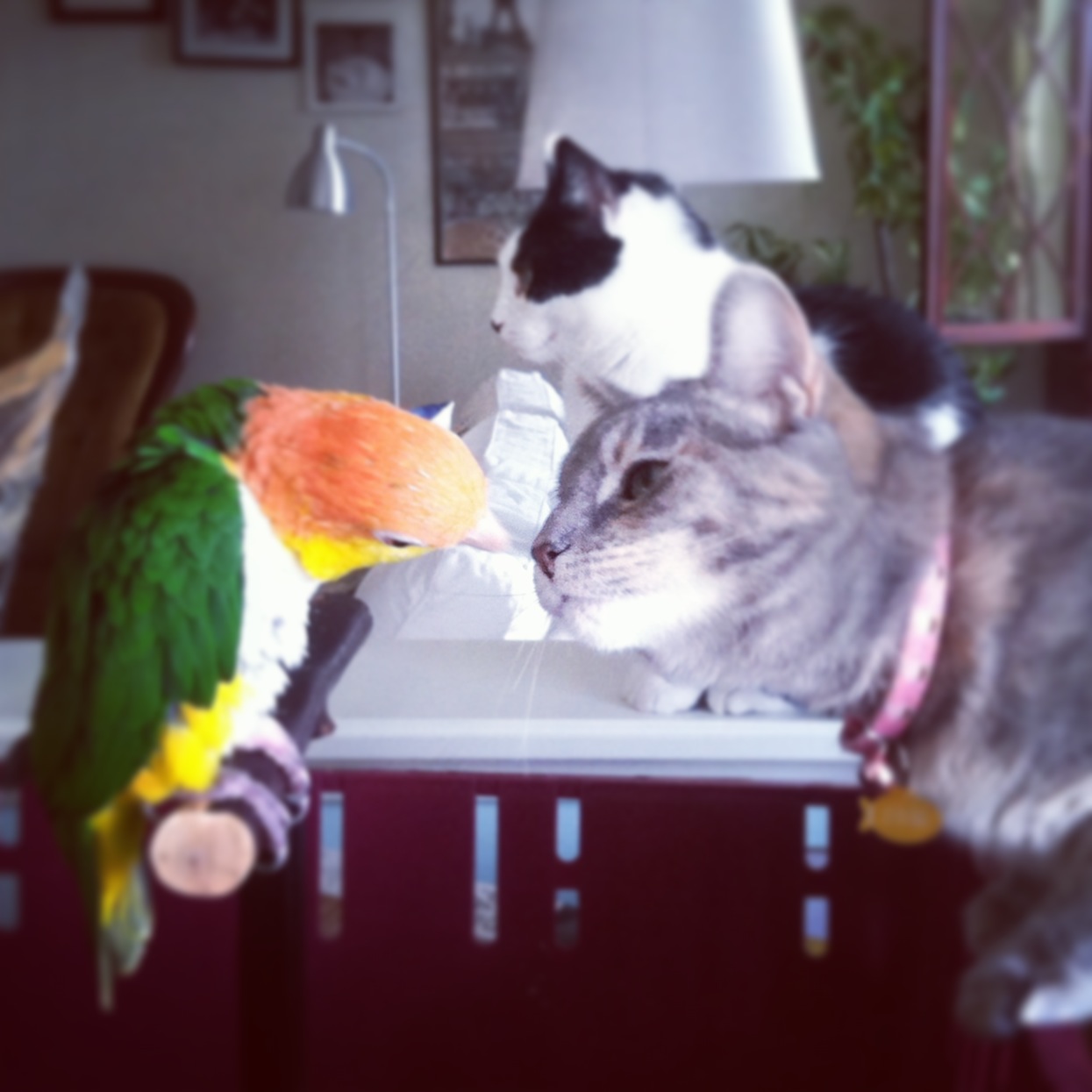 The short answer is no! We have seen a number of videos lately showing cats interacting with birds, usually in a friendly way. In some pictures and videos the bird rides on the cat's back and the two even groom each other. It's always possible prey and predator species can form a bond and exist peacefully together, but we tend to see what happens when contact is a bit more aggressive, even if unintentional. Cats naturally have bacteria in their mouths that they can spread to feet and claws when grooming. These bacteria can be particularly dangerous if they enter the body through breaks in the bird’s skin, or through what even seems to be a tiny bite or scratch.
For this reason, we recommend birds and cats look, but don’t touch! Be aware we know of several cases where cats reached through the bars of cages and grabbed birds inside!
The short answer is no! We have seen a number of videos lately showing cats interacting with birds, usually in a friendly way. In some pictures and videos the bird rides on the cat's back and the two even groom each other. It's always possible prey and predator species can form a bond and exist peacefully together, but we tend to see what happens when contact is a bit more aggressive, even if unintentional. Cats naturally have bacteria in their mouths that they can spread to feet and claws when grooming. These bacteria can be particularly dangerous if they enter the body through breaks in the bird’s skin, or through what even seems to be a tiny bite or scratch.
For this reason, we recommend birds and cats look, but don’t touch! Be aware we know of several cases where cats reached through the bars of cages and grabbed birds inside!
If you suspect your bird has been exposed to a cat bite or scratch, call the clinic right away. Rapid wound care, including antibiotics, are extremely important to prevent a potentially fatal systemic infection that can develop in as little as 24-48 hours.
It is Spring, and Romance Is In the Air, For Parrots
 Increasing light cycles can lead to elevated reproductive hormone levels in some pet birds, especially birds receiving unintended stimuli from well-intentioned owners.
Reproductive activity in pet birds can be temporary and of little serious consequence; however, in many cases chronic stimulation in female birds often leads to disease of the reproductive tract, which can be severe, and in some cases life-threatening.
Increasing light cycles can lead to elevated reproductive hormone levels in some pet birds, especially birds receiving unintended stimuli from well-intentioned owners.
Reproductive activity in pet birds can be temporary and of little serious consequence; however, in many cases chronic stimulation in female birds often leads to disease of the reproductive tract, which can be severe, and in some cases life-threatening.
Client education is key to prevention. See the following link to view a client educational video that gives a general overview of this topic: https://www.youtube.com/watch?v=PZ7FPB4vIcQ
Some birds benefit from GnRH agonists such as leuprolide or deslorelin in addition to behavioral modification. Email us for more information on this important topic.
Euthanasia of Exotic Pets: What Are the Options?
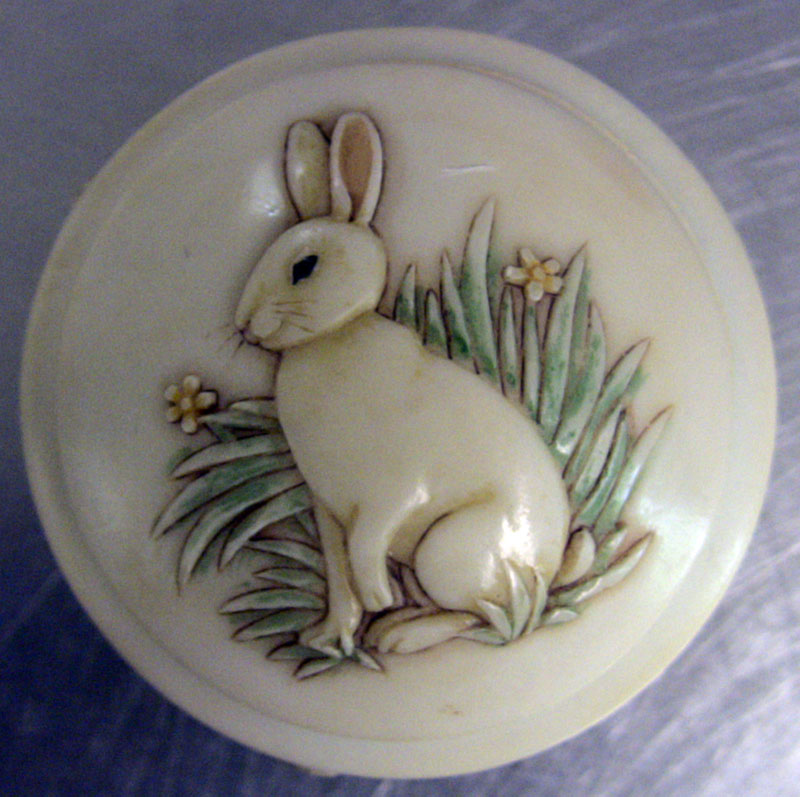 Human euthanasia of exotics pets can be challenging, especially in smaller patients, and when owners wish to be present. Methods typically used in traditional pet species, in particular the use of IV euthanasia agents in the conscious pet, are often too stressful for exotics.
The AVMA Guidelines for the Euthanasia of Animals: 2013 Edition contains a wealth of useful information on the entire process, While guidelines have existed since 1963, the 2013 version greatly expanded specific species recommendations, including those for exotic pet species such as birds, reptiles, small mammals, fish and even crustaceans and fertile eggs:
Human euthanasia of exotics pets can be challenging, especially in smaller patients, and when owners wish to be present. Methods typically used in traditional pet species, in particular the use of IV euthanasia agents in the conscious pet, are often too stressful for exotics.
The AVMA Guidelines for the Euthanasia of Animals: 2013 Edition contains a wealth of useful information on the entire process, While guidelines have existed since 1963, the 2013 version greatly expanded specific species recommendations, including those for exotic pet species such as birds, reptiles, small mammals, fish and even crustaceans and fertile eggs:
www.avma.org/KB/Policies/Documents/euthanasia.pdf
Our preference uses two steps: the first is simple IM injection of anesthetic agents. Once the pet is completely anesthetized (which may require additional doses), euthanasia solution can be delivered IV, IO, IP, intracardiac or into kidney or liver. It should be noted AVMA guidelines does not recommend the use of inhalant agents alone to induce anesthesia (this technique is stressful and should be strictly avoided for any purpose); euthanasia solution also must not be delivered any route other than IV or possibly IP in the conscious patient.
Questions on stress free euthanasia for exotic pets? Email or call, and we can help.
A Big Thank You to Our Friends at Animal Care Services!
 We would like to take this time to thank a group of hard working individuals who work all year round behind the scenes: our local Marion County Animal Care Services! While we think of Animal Control’s job as handling calls related to stray or mistreated dogs and cats, Control officers are continually bringing us sick or injured wildlife reported by the public, and sometimes even pet exotics that have been turned loose or are being neglected. These guys work really hard to make sure everything possible is done for the critters in their care and definitely don't deserve the bad reputation that comes with the name "Animal Control"!
Wildlife season is upon us, and we expect to see a lot more of our friends very soon.
We would like to take this time to thank a group of hard working individuals who work all year round behind the scenes: our local Marion County Animal Care Services! While we think of Animal Control’s job as handling calls related to stray or mistreated dogs and cats, Control officers are continually bringing us sick or injured wildlife reported by the public, and sometimes even pet exotics that have been turned loose or are being neglected. These guys work really hard to make sure everything possible is done for the critters in their care and definitely don't deserve the bad reputation that comes with the name "Animal Control"!
Wildlife season is upon us, and we expect to see a lot more of our friends very soon.
So a big THANK YOU for all you do!
The Debate on Indoor vs. Outdoor Cats: Why Does AEAC Care?
For years there has been ongoing debate on what the veterinary medical community should recommend to owners in regard to indoor vs. free roaming pet cats. It's been shown that free ranging cats have shorter lifespans, and are more prone to accidents, predators, parasites and infectious diseases. In addition, evidence now shows that outdoor cats 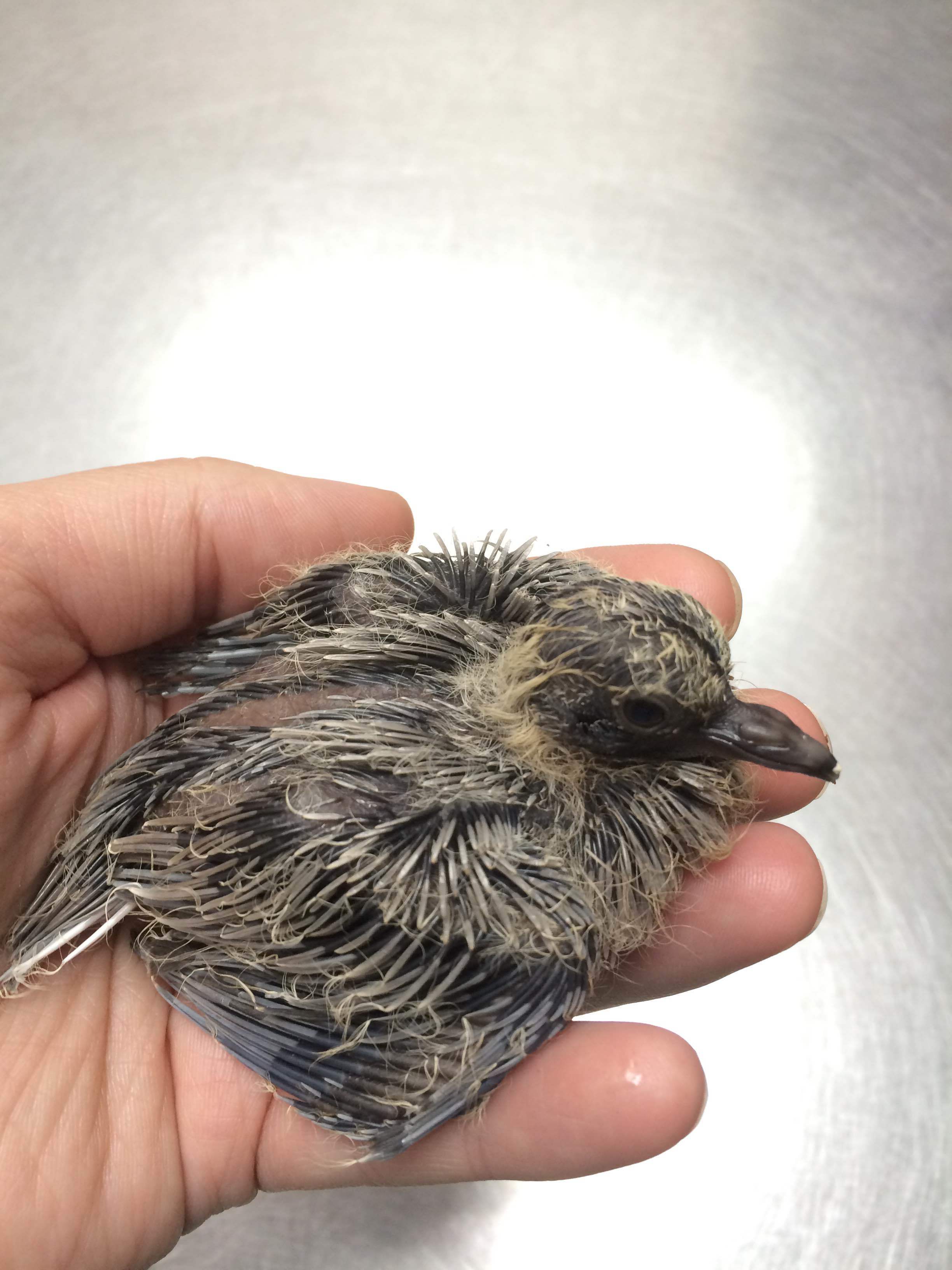 have already made a significant negative impact on native wildlife populations, in particular wild birds, some of whose numbers are declining and may be threatened eventually. Every year concerned citizens come to our door with injured birds and mammals their cats have caught outdoors, or even brought inside as "presents". Most of these do not survive.
For this reason, AEAC supports the American Veterinary Medical Association (AVMA) position on out door cats which is available here: https://www.avma.org/KB/Policies/Pages/Free-Roaming-Owned-Cats.aspx
have already made a significant negative impact on native wildlife populations, in particular wild birds, some of whose numbers are declining and may be threatened eventually. Every year concerned citizens come to our door with injured birds and mammals their cats have caught outdoors, or even brought inside as "presents". Most of these do not survive.
For this reason, AEAC supports the American Veterinary Medical Association (AVMA) position on out door cats which is available here: https://www.avma.org/KB/Policies/Pages/Free-Roaming-Owned-Cats.aspx
For many years, the Association of Avian Veterinarians has recommended keeping cats indoors, primarily due to the impact on native birds. The position statement can be found here: : http://www.aav.org/default.asp?page=feralcats
Spring is Almost Here, And That Means Easter….and Maybe Easter Bunnies?
 At the Avian and Exotic Animal Clinic, we love pet rabbits. We love people who love pet rabbits. However, in the weeks after Easter, our local rescue partners see an upswing in the number of rabbits relinquished by well-meaning people who bought Easter Bunnies on impulse without a lot of thought about what goes into caring for a pet who can live for 10 years or more.
The House Rabbit Society has a wonderful article on the Easter Bunny Problem you can read here:http://rabbit.org/easter-and-rabbits-do-not-mix/
At the Avian and Exotic Animal Clinic, we love pet rabbits. We love people who love pet rabbits. However, in the weeks after Easter, our local rescue partners see an upswing in the number of rabbits relinquished by well-meaning people who bought Easter Bunnies on impulse without a lot of thought about what goes into caring for a pet who can live for 10 years or more.
The House Rabbit Society has a wonderful article on the Easter Bunny Problem you can read here:http://rabbit.org/easter-and-rabbits-do-not-mix/
If you are considering a pet rabbit at Easter, or any time of the year, we would love to talk about it! The Avian and Exotic Animal Clinic offers free “Pre-Purchase Consults” where you and your family and learn the ins and outs of rabbit (or any exotic pet) ownership BEFORE you purchase. Call 317-879-8633 to schedule.
We Offer Pre-Purchase Consultations!
Have you ever though about coming to see the veterinarian BEFORE you buy an unusual exotic pet? This is an excellent way to be sure you understand exactly what’s involved in day-to-day care, and learn strategies to avoid and minimize illness. The internet and pet stores are great places to start for information, but not everything you read or hear may be accurate or up-to-date. We also encourage the entire family to attend, including children who may be part of your new pet’s care. We’ll be sure everyone’s on the same page, and provide written care instructions.
Give us a call and schedule a pre-purchase consult now…best of all, they are FREE!
Heroic Pet Bearded Dragon "Donor" Donates Blood
Highlights from NAVC 2017
Dr. Swisher attended the exotics session at the North American Veterinary Conference in February, 2017. Here are some highlights from the Exotic Companion Mammal (ECM) sessions: a) Endocrinology: Some endocrine diseases have long been recognized in ECM, including adrenal disease and insulinoma in ferrets, cystic ovaries in guinea pigs, pituitary adenomas in rats, and diabetes mellitus in hamsters and degus. However, in recent years, there has been increasing recognition of other, less common endocrine diseases, including hyperthyroidism in guinea pigs and rabbits, Cushing's disease in hamsters, adrenal disease in rabbits, and disorders of the pancreas (DM or insulinoma) in many species. b) Idiopathic hematuria in guinea pigs: While hematuria in guinea pigs is typically attributed to urinary tract infection or urolithiasis, there is increasing evidence that guinea pigs may also develop sterile cystitis of unknown etiology. This emphasizes the importance of performing appropriate diagnostics, including urinalysis, urine culture, and imaging. Note that previous studies have demonstrated that almost all free catch samples from guinea pigs are contaminated with bacteria, so this is not an appropriate technique for diagnosis of UTI. Some guinea pigs with sterile cystitis may respond to NSAID therapy and husbandry changes to increase water consumption.
Liver Lobe Torsion in Rabbits
A 3-year-old female rabbit presented for vague signs (decreased appetite and stool, less active), and physical examination findings (mild abdominal discomfort upon palpation) consistent with Rabbit Gastrointestinal Syndrome (RGIS). What is your next diagnostic or treatment step? Many underlying disease conditions can cause this clinical presentation, some mild, and some potentially catastrophic, e.g. GI foreign body obstruction.
For this reason, rabbits presenting with RGIS should ideally undergo a diagnostic work up, including abdominal radiographs and a biochemistry panel. Dr Jennifer Graham’s excellent article (below) found that the overwhelming majority of rabbits with liver lobe torsion had a similar presentation, but showed an elevation in liver enzymes; in each case, diagnosis was confirmed by use of hepatic ultrasound with Doppler assessment. Rapid surgical intervention and liver lobectomy was curative.
Read more here.
Journal of Exotic Pet Medicine 23(3); 2014.
Liver Lobe Torsion in Rabbits: 16 Cases (2007 to 2012)
Jennifer E. Graham,DVM, Dip. ABVP (Avian; Exotic Companion Mammal), Dip. ACZM; Connie J. Orcutt,DVM, Dip. ABVP (Avian; Exotic Companion Mammal); Sue A. Casale,DVM, Dip. ACVS; Patty J. Ewing,DVM, MS, Dip. ACVP; Jessica Basseches,DVM, Dip. ACVR
Meloxicam in Rabbits
Anesthetic and analgesic pharmacokinetic studies are continually helping us to revise our dosages and protocols for exotic species. A recent example is Meloxicam use in rabbits; while earlier formularies suggest a dosage of 0.2 mg/kg PO, a 2013 pharmacokinetic study suggested clinically useful dosages are likely much higher. See the following article for more information: Am J Vet Res. 2013 Apr;74(4):636-41 Pharmacokinetics of meloxicam in rabbits after oral administration of single and multiple doses. Fredholm DV1, Carpenter JW, KuKanich B, Kohles M.
Our current dosage recommendation for short-term use of Meloxicam in well-hydrated, normovolemic rabbits without evidence of renal dysfunction is 0.8-1.0 mg/kg PO. The authors of the study conclude:
"Plasma concentrations of meloxicam for rabbits in the present study were proportionally higher than those previously reported for rabbits receiving 0.2 mg of meloxicam/kg and were similar to those determined for animals of other species that received clinically effective doses. A dose of 1 mg/kg may be necessary to achieve clinically effective circulating concentrations of meloxicam in rabbits, although further studies are needed."
Outbreak of Seoul Virus in Rats
The Indiana State Department of Health alerted veterinarians and other health professionals about an outbreak of a virus that was found in pet rats sold and shipped from Illinois and Wisconsin after September 1, 2016.
The Seoul virus is related to hantavirus; while hantavirus can cause severe illness, the Seoul virus is much less severe.
The board of health is alerting owners who might have purchased rats from this facility.
If you have any questions about exposure to rats purchased from Illinois and Wisconsin after September 1, call the Indiana State Department of Health (ISDH) Epidemiology Resource Center at 317-233-7125.
More information about the Seoul virus can be found here: https://www.cdc.gov/hantavirus/outbreaks/seoul-virus/index.html.
The ISDH recommends the following preventive measures for all rodent owners:
- Wash your hands with soap and running water after touching, feeding, or caring for rodents or cleaning their habitats. Be sure to assist children with handwashing.
- Be aware that pet rodents can shed germs that can contaminate surfaces in areas where they live and roam. Make sure rodent enclosures are properly secured and safe so your pet doesn’t get hurt or contaminate surfaces.
- Clean and disinfect rodent habitats and supplies outside your home when possible. Never clean rodent habitats or their supplies in the kitchen sink, other food preparation areas, or the bathroom sink.
- Avoid bites and scratches from rodents. Be cautious with unfamiliar animals, even if they seem friendly. Take precautions when cleaning out rodent cages or areas with rodent urine or droppings.
- Visit your veterinarian for routine evaluation and care to keep your rodents healthy and to prevent infectious diseases.
Pet Chicken Day!
Bats and Rabies: The Risk Is REAL And Here In Central Indiana
 Last week the Avian and Exotic Animal Clinic took in a sick Brown bat found by a local family. The bat did not survive, and was sent to the Indiana State Department of Health for testing. Unfortunately the bat was positive for rabies virus. The family and everyone exposed to the bat will now need treatment for rabies exposure. This episode emphasizes the fact that while rare, rabies is present in Indiana and is a potential danger to anyone handling wildlife, especially bats, skunks, raccoons, and foxes. While AEAC will accept injured and orphaned wildlife, we urge the public to contact Animal Control or local law enforcement, and do not handle potential rabies carriers, especially bats.
“Bats are the most important rabies carriers in the state of Indiana,” said Dr. Jen Brown, State Public Health Veterinarian at the Indiana State Department of Health. “It is best not to handle live bats. Anyone who has had possible contact with a bat should call the local health department for advice on whether to receive rabies shots. If a possible exposure has occurred, then the bat should be safely collected so that it can be tested for rabies.”
Last week the Avian and Exotic Animal Clinic took in a sick Brown bat found by a local family. The bat did not survive, and was sent to the Indiana State Department of Health for testing. Unfortunately the bat was positive for rabies virus. The family and everyone exposed to the bat will now need treatment for rabies exposure. This episode emphasizes the fact that while rare, rabies is present in Indiana and is a potential danger to anyone handling wildlife, especially bats, skunks, raccoons, and foxes. While AEAC will accept injured and orphaned wildlife, we urge the public to contact Animal Control or local law enforcement, and do not handle potential rabies carriers, especially bats.
“Bats are the most important rabies carriers in the state of Indiana,” said Dr. Jen Brown, State Public Health Veterinarian at the Indiana State Department of Health. “It is best not to handle live bats. Anyone who has had possible contact with a bat should call the local health department for advice on whether to receive rabies shots. If a possible exposure has occurred, then the bat should be safely collected so that it can be tested for rabies.”
It's interesting to note that in the US, we are actually fortunate when it comes to rabies exposure. According to the World Health Organization, tens of thousands people die of rabies each year, mostly in Asia (especially India) and Africa. The victims are mostly children, and the source is overwhelmingly unvaccinated dogs. Routine vaccination of pets in the US is an amazing success story, and owners should be congratulated and encouraged to keep up our defenses against this terrible disease.
For more information on India's rabies crisis, go here: http://www.bbc.com/future/story/20150915-indias-rabid-dog-problem-is-running-the-country-ragged
Hello From the Hay Fields of Nebraska!
Small Pets 101 Seminar in Indy
Biennial Pet Bird Symposium at PVM
Want 9 Avian Medicine CE credit hours close to home? Join us for the Biennial Pet Bird Symposium November 13-14 at Purdue University. Featured topics include: “Commonly Kept Parrot Species and Their Characteristics,” “Update on Viral Diseases and Chlamydophila,” “Sedation, High Risk Anesthesia and Critical Care Management,” “Cloacal Prolapse Management,” “Dermatologic Conditions,” “The Geriatric Parrot,” and “Renal System Disorders.”
Speakers include Purdue Veterinary Medicine clinicians: Dr. Steve Thompson, clinical associate professor and director of the Pet Wellness Clinic, and Dr. Lorraine Corriveau, wellness clinician in the Small Animal Community Practice; as well as ABVP Board Certified Avian Specialist Dr. Angela Lennox, and Dr. Bianca Zaffarano, Iowa State University College of Veterinary Medicine faculty clinician.
In addition to lectures, the program will include a variety of case-based discussions. Topics are suitable for both veterinarians and veterinary technicians. Click here for more information, and to register.
Nine continuing education (CE) credits will be offered for this symposium.
Click here for more information.
Congratulations to Our Two Brand New Veterinary Technicians!
Avian and Exotic Animal Clinic is proud to announce Brie Worrell and Savannah Goins recently passed their qualifying exams and have graduated from Veterinary Assistant to Registered Veterinary Technician. They join Kasey Gardner who passed her exam in the spring.
So what’s the difference between veterinary assistant and technician?
A Veterinary Technician is a highly trained veterinary nurse qualified to assist with a number of important jobs, such as monitoring anesthesia and running diagnostic tests. It is these bright professionals who work hard to keep our patients safe during surgery.
Both Brie and Savannah spent time during their training learning with us, and joined our team right after finishing class work. Both passed the qualifying test together in August, and we are very proud of both of their efforts.
Are you or someone you know interested in a career as a veterinary technician? Here is advice from Brie and Savannah:
Advice to future vet techs:
Start getting experience with animals as early as possible! Volunteering or working as an assistant in a vet clinic are both great places to start. In order to become a Registered Veterinary Technician, you must graduate from an accredited veterinary technician school. This is a two year degree program, though some schools offer an accelerated 18 month program instead. Once you start the program, stick with it! And if possible continue working or volunteering in a vet clinic to continue increasing your experience. Once you've graduated with a degree in veterinary technology, you have to pass the Veterinary Technician National Exam as well as the state exam for which ever state you want to be registered in. That is the process in a nutshell. Good luck!











